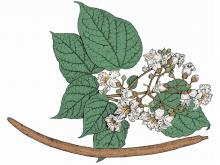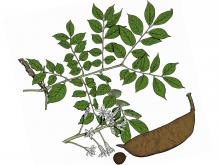Trees, Shrubs and Woody Vines
Media

Species Types
Scientific Name
Asimina triloba
Description
“Way down yonder in the pawpaw patch” is an old song you might be familiar with — but today, surprisingly few Missourians know a pawpaw tree when they see one. This is a good tree to know, especially when the large, sweet fruit are ripening!
Media

Species Types
Scientific Name
Maclura pomifera
Description
Osage orange is a densely branched, short-trunked, thorny tree. It bears weird-loooking, softball-sized, chartreuse, brainlike fruits, which often lie beneath the tree in abundance in autumn.
Media

Species Types
Scientific Name
Euonymus fortunei
Description
Introduced from Asia as a groundcover, wintercreeper has escaped cultivation in all the eastern states. It’s frequently found near urban centers, with heavy infestations in woodlands around St. Louis and Kansas City.
Media

Species Types
Scientific Name
Campsis radicans
Description
Each summer, the bright orange and red “trumpets” of this woody vine decorate Missouri’s cliff faces, telephone poles, and anything else strong enough to support it. Hummingbirds zoom to trumpet creeper’s flowers for their nectar.
Media

Species Types
Scientific Name
Cornus amomum
Description
Swamp dogwood, or silky dogwood, grows nearly statewide in wet locations. Recognize it by its reddish-brown or dark brown young branchlets and blue, berrylike fruit, conspicuous in late fall.
Media

Species Types
Scientific Name
Cornus spp.
Description
Missouri’s five species of dogwoods are shrubs or small trees with distinctive flowers, fruits, and bark. The fruits may be red, white, or blue. The leaves have characteristic arching veins.
Media

Species Types
Scientific Name
Catalpa speciosa
Description
Of the three species of catalpas in our state, northern catalpa is the only one native to Missouri (specifically, the Bootheel region). It has been planted widely, though, and has naturalized in many places. A popular ornamental and shade tree with pretty, orchidlike flowers and long, beanlike fruit.
Media

Species Types
Scientific Name
Cornus foemina
Description
Gray dogwood is a deciduous, thicket-forming shrub. Its small, creamy-white flowers occur in branched clusters, and its white or pale blue fruits are supported by red stalks — a characteristic that makes it attractive for ornamental uses.
Media

Species Types
Scientific Name
Cornus drummondii
Description
Rough-leaved dogwood is one of Missouri's hardiest shrubs, capable of withstanding cold and drought. The leaves of this thicket-forming species emit a faint odor of sour milk.
Media

Species Types
Scientific Name
Gymnocladus dioicus
Description
There’s no mistaking Kentucky coffee tree when its large, tough seedpods are hanging from its limbs or dropping to the ground below. Unpopular as food with today’s wildlife, these seedpods might have fed mastodons and other large, extinct North American mammals.
See Also
About Trees, Shrubs and Woody Vines in Missouri
There are no sharp dividing lines between trees, shrubs, and woody vines, or even between woody and nonwoody plants. “Wood” is a type of tissue made of cellulose and lignin that many plants develop as they mature — whether they are “woody” or not. Trees are woody plants over 13 feet tall with a single trunk. Shrubs are less than 13 feet tall, with multiple stems. Vines require support or else sprawl over the ground.





















